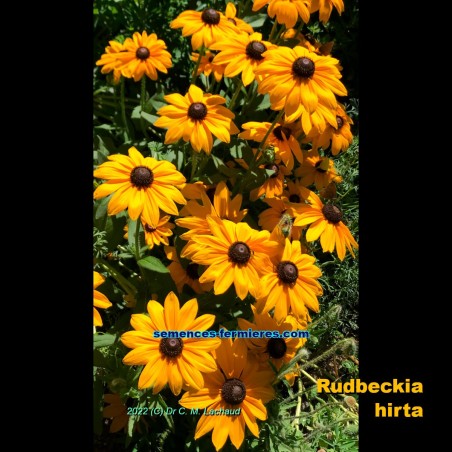





Rudbeckia hirta - Dyer's Rudbeckia
1 packet of 20 seeds
-
Rudbeckia hirta is a meadow plant domesticated for its superb, abundant and very long-lasting flowering, both in the garden and as a cut flower
There are many varieties of Black Eyed Susan, giving dwarf or tall plants, various sizes and shapes of flowers, and colors ranging from yellow, orange, mahogany, and dark pink, including bicolor
The Dyer's Rudbeckia forms a tuft of hairy leaves that are wider than they are tall, slightly glaucous green
They emerge from a stump of fleshy roots and last in winter when the frosts are not too severe
During spring, several erect stems emerge, with little branching, at the end of which unfolds a very large, yellow-orange flower with a dark center
The actual flowers, tiny and grouped in flower heads (the heart of what we call "flower"), are insignificant, and once passed, the "flower" lasts for weeks or even months
-
| Jan | Feb | Mar | Apr | May | Jun | Jul | Aug | Sep | Oct | Nov | Dec | ||
|---|---|---|---|---|---|---|---|---|---|---|---|---|---|
| Z4 | |||||||||||||
| etc. | |||||||||||||
Sow the seeds of Rudbeckia hirta in March or April, in the nursery, 3-4 seeds per pot, packing them on top of potting soil kept moist, or barely covering them
Expose to the sun, warm, and keep moist
Germination is quite rapid in these spring conditions
Grow for a few weeks in the nursery until seedlings are strong enough to go in the garden
Plant Rudbeckia hirta in the center of a clump or isolated in a rockery, in full sun, in moderately fertile, clean, well-worked soil
Water until recovery, and protect the young plant from slugs and snails (precaution not necessary with adult plants)
Thereafter, it is a maintenance-free plant apart from weeding to keep it clean and aesthetic
In autumn, cut the flower stems at ground level
Rudbeckia hirta grows back in spring, generally for several years (ephemeral perennial)
No diseases, the fleshy roots can be devoured by insect larvae and voles
You might also like
Payment :
PayPal < 150 €
Check < 850 €
Bank Wire > 149 €
Thank you for your kind understanding